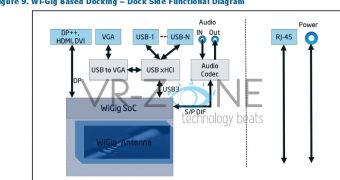The WiGig technology of the Wireless Gigabit Alliance is what Intel wants to use for its next ultrabook-related project, but there might be a few issues.
Simply put, Intel wants to create a dock that can wirelessly communicate with ultrabooks at 60GHz.
The WiGig Alliance already has the technology, the Ultra Wide Band, which is backwards compatible with 5 GHz and 2.4 GHz bands.
Intel's reported goal is to remove the need for wires from the equation when linking the dock to the laptop.
There are some problems that have no visible solution yet, though, one of which is how the Ethernet cable still has to go into the Ultrabook itself if one wants to use vPro or other network features.
Also, though wireless docks are all well and good, that sort of communication takes power, so users will have to eventually link the laptop to a power outlet (the dock too).
There are still some benefits, however, or at least potential benefits, depending on what Intel wants the dock to offer.
Assuming that the WiGig dock will have display interfaces, audio and USB, 60 GHz will be more than enough to stream data over to them (and from them).
Unfortunately, as always, wireless technologies involve higher costs, and getting cheaper is what ultrabooks should worry about right now.
For those who aren't up to speed on all things WiGig, the alliance is working on extending the 802.11 to speeds of 7 Gbps, which is 10 times the so-called 'peak' of the technology.
Marvell, Cisco, Broadcom, AMD, Intel, Qualcomm and various others are part of the consortium.
The WiGig standard hasn't precisely been launched yet, though, so if Intel does push forward with this, it won't yield any palpable products for a while.
The Santa Clara giant has other projects to work on in the meantime, like getting the thunderbolt technology on these super-thin notebooks.

 14 DAY TRIAL //
14 DAY TRIAL //